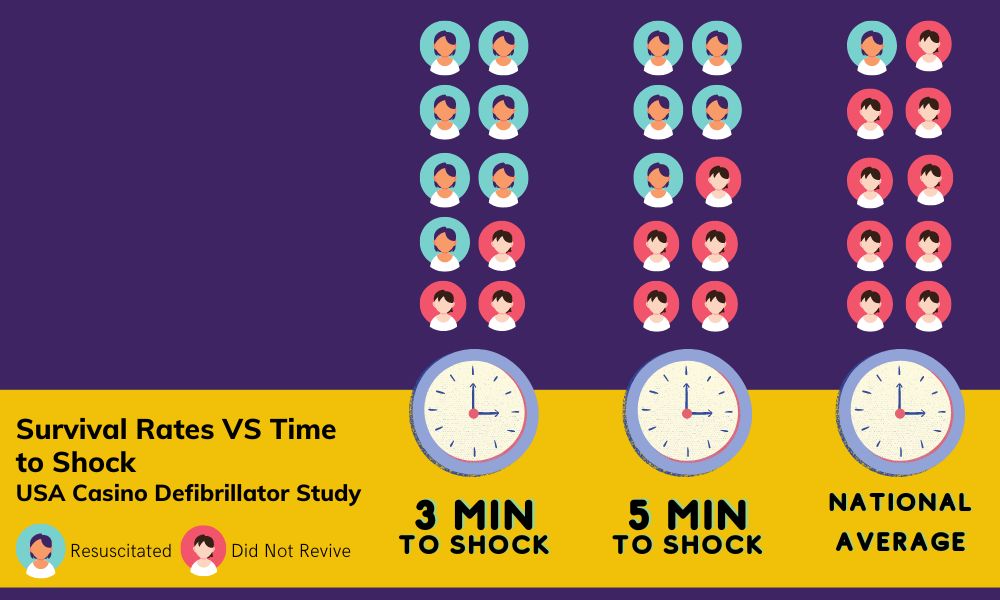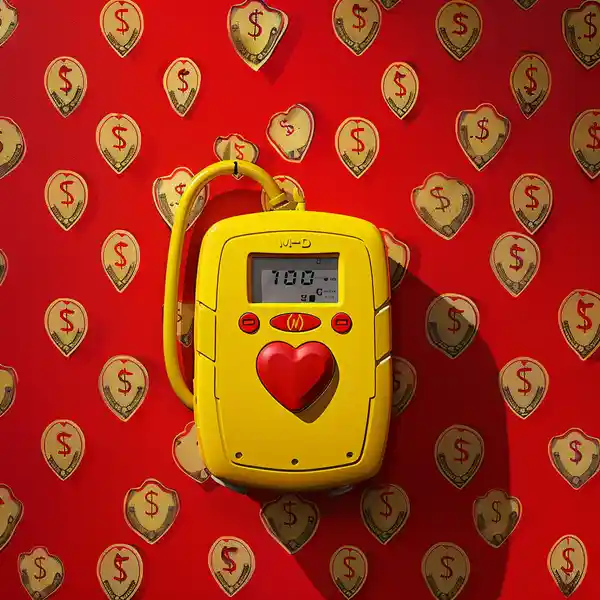A Home Defibrillator: The Life-Saving Choice

Hey! Interested in getting a home defibrillator? We’ve made a great guide to help you learn about them. We’ll help you decide if you need one and give you advice on what to look for
In the blink of an eye, the unexpected can occur. A leisurely day at home can suddenly turn into a critical situation when a family member experiences a sudden cardiac arrest. It’s a frightening scenario that occurs all too often, and with every passing minute, the chance of survival diminishes. The truth is, ambulance response times may not always be swift enough, and a home defibrillator could mean the difference between life and death.
The growing market for home defibrillators reflects a society more conscious of health and safety. But with various models, brands, and an influx of information, making the right choice becomes a daunting task. Should you opt for the cheapest defibrillator at a seemingly affordable price? Or perhaps a more established brand with a known track record?
Investing in a home defibrillator is more than just a financial decision; it’s an investment in safety, assurance, and the well-being of those you love. But how do you navigate the complexities of quality versus price, energy output, lifespan, and brand reputation? How can you ensure you’re making a choice that aligns not just with your budget but with the highest standards of care?
In this comprehensive guide, we will explore the ins and outs of home defibrillators, compare leading models, debunk common misconceptions, and ultimately help you make an informed decision that puts the value of life above all else. Whether you’re a concerned parent, a responsible caregiver, or an individual considering the future, this is your starting point to understanding and investing in the right defibrillator for you.
Section 1: The Growing Importance of Home Defibrillators
Home Defibrillator Vs Ambulance Response Times: The critical minutes in emergencies

In Australia, ambulance response times can vary significantly. Each minute’s delay in defibrillation reduces survival rates by 10%. Getting defibrillation between 3-5 minutes of a cardiac arrest gives you a higher chance to survive. How long would it take you to have an ambulance arrive? If you buy a defibrillator for home you can make a crucial difference in those vital minutes before professional help arrives.
Life’s Accidents: How safety can’t be left to chance
More than 30,000 Australians suffer from out-of-hospital cardiac arrests each year, with a less than 10% chance of survival. Access to immediate defibrillation can be life-saving, providing a security net in an unpredictable world.

Middle-aged and Older Individuals: Unique Risks
Age is a significant factor in sudden cardiac arrests. If you have middle aged or older individuals at your home, or a family history of cardiac arrest. A home defibrillator acts as a precautionary measure for this at-risk age group, offering reassurance and tangible protection.
Security Investment: Emotional peace of mind
Having a defibrillator at home isn’t just about physical readiness; it also brings emotional comfort. It’s an investment in peace of mind. Like having a spare tire in your car – it’s there if you need it.
Cost of Living Consideration: How investing in a defibrillator compares to other regular expenses
Australians spend an average of AUD $2796 per year on dining out. Compared to this regular expenditure, investing in a home defibrillator seems like a sensible prioritization. After all, it provides security and safety for you and your family.
Here’s How Time Makes A Difference

Section 2: Understanding Home Defibrillators
To buy a defibrillator for home use. A Life-Saving Investment
Defibrillators are invaluable devices designed to correct life-threatening heart rhythms that can lead to cardiac arrest. Used alongside CPR, they significantly increase the chance of survival, making them an essential addition to every household.
Ease of Use: Lifesaving Simplicity at Your Fingertips
Home defibrillators are designed with ease of use in mind, making them accessible to everyone, regardless of prior medical knowledge. The moment you turn it on, the device begins to speak to you. It guides you step-by-step through the process with calm and clear instructions.

First, it might instruct you to place the pads on the patient’s chest. Most defibrillators have pictures telling you exactly where to put them. Then, it analyzes the heart’s rhythm on its own, telling you exactly what to do next. If a shock is required, a loud, clear voice will either prompt you to press a single button, or in some cases just give the shock automatically.
There’s no need for guesswork or medical expertise; the defibrillator leads you through each stage with reassuring precision. It’s as simple as listening and following along, turning what could be an overwhelming situation into a manageable one. Owning a home defibrillator is like having a medical expert standing by, ready to assist you in those critical moments. It’s lifesaving made simple.
Usage during CPR: A Partnership That Saves Lives
CPR (Cardiopulmonary Resuscitation) keeps the blood flowing, but only a defibrillator can restore the heart’s normal rhythm. Together, they form a powerful partnership in emergency response, potentially turning a tragic situation into a life-saving success.
Defibrillator and CPR: Clearing Up Misconceptions
Defibrillators complement CPR rather than replace it. Far from being an alternative, a defibrillator enhances CPR’s effectiveness, offering the best possible chance for survival. Owning a defibrillator means being equipped for the unexpected, ready to act when every second counts.
Importance in CPR: Why a Defibrillator Is a Must-Have
Using a defibrillator and CPR for a cardiac arrest can increase survival rates from less than 10% to over 70%. As each minute passes without defibrillation, the chance of survival decreases rapidly. Having a defibrillator at home is not just a smart choice; it’s a life-affirming one.
Cost Consideration: An Investment Worth Making
With many affordable options on the market, including Cell-AED, a defibrillator is an investment in safety that compares well to other household expenditures. Considering its potential to save a life, its value is immeasurable.
Section 3: The Right buy for a Home Defibrillator – Quality vs. Price
Home Defibrillator Comparison: An overview of factors to consider – price, quality, brand reputation
When investing in a home defibrillator, price, quality, and brand reputation are key factors to weigh. The initial cost might be alluring, but long-term considerations are crucial. Heartsine’s defibrillators, although having a higher upfront price, stand out as a smarter choice in the long run. With superior quality, durability, and brand reliability, Heartsine proves to be an investment that could save lives without burdening the budget over time.

Home Defibrillator Brands: Introduction to Cell-AED vs. Heartsine
Among the various brands in the market, Cell-AED and Heartsine have their own appeal. While Cell-AED offers a seemingly attractive initial price, Heartsine’s models shine in terms of quality, energy delivery, and long-term cost-effectiveness. With benefits like higher energy output and faster response times, Heartsine aligns better with the needs of a home setting.
Australia’s Cheapest Defibrillators compared, including pricing, lifespan, energy output,

- Price: Though Cell-AED’s $499 initial price seems tempting, it only has a 2-year lifespan ($1996 over 8 years*). Comparatively, Heartsine’s 350p/360p model, priced around $1800 for 8 years (including maintenance costs*), proves to be more economical over time.
- Lifespan: Heartsine offers an 8-year warranty, showing confidence in its products, while Cell-AED’s 2-year guarantee falls short.
- Energy Output: With 68-81 joules, Cell-AED differs from the suggested 200 joules from the Australian Resuscitation council, compare this to the up to 200j delivered by Heartsine.
- Maintenance Cost: Heartsine’s free replacement of pads/batteries after a verified cardiac event outshines Cell-AED’s $499 replacement charge unless enrolled in their specific program.
- Ease of Use for Children Under 8 or 25kgs: Cell AED is awkward to use on children and requires extra steps that most other AED’s do not. Heartsine AED’s are easy to use on children, especially when paired with a paediatric pad-pak.
Conclusion: A balanced view of why Heartsine may be a better choice
Cell-AED’s low initial cost may attract some buyers, but an in-depth look reveals that Heartsine’s combination of quality, effectiveness, and affordability makes it the prudent choice. With advanced features, robust design, and a focus on long-term benefits, Heartsine distinguishes itself as a wise investment for families, individuals, and communities.
Section 4: The Biggest Home Defibrillator Misconception
The Cost Dilemma: How a Home Defibrillator Compares to Household Expenditures

A common misconception surrounding home defibrillators is the presumed high cost of ownership. However, when weighed against everyday household expenses, the investment in this life-saving device appears both practical and essential.
A quality home defibrillator like Heartsine including some basic maintenance costs can work out to be $1,800 and providing coverage for 8 years. When broken down, this amounts to roughly $225 per year. That’s a small amount to pay to save the life. In this consumer world where people often upgrade their phones every few years, $1800 is a small price to pay.
The question then arises: What value do we place on the safety and well-being of ourselves and our family? When contrasted with other discretionary spending, the choice becomes clear. Investing in a defibrillator is not just reasonable, but a thoughtful, life-affirming decision.
Moreover, with the increasing cost of living in Australia, prioritizing safety becomes an act of sensible financial planning. A home defibrillator falls within the same budgetary category as other quality-of-life investments, offering an unparalleled benefit – the potential to save a life.
Here’s how they compare

Section 5: The Heartsine 350P and 360P – The Best Choice for a Home Defibrillator

Overview of Heartsine 350P and 360P
The Heartsine 350P and 360P models stand out in the world of home defibrillators, offering an excellent balance between quality, usability, and cost-effectiveness. Crafted with the everyday user in mind, these models make the defibrillation process accessible and straightforward.
Why Choose Heartsine 350P or 360P?
- Ease of Use: Both the 350P and 360P are designed with clear visual and verbal instructions that guide users through every critical step. Their simplicity and efficiency make them valuable additions to any household, regardless of medical expertise.
- Affordability and Low Maintenance: With an 8-year warranty and minimal ongoing maintenance costs, the Heartsine models are cost-effective without compromising quality. This balance sets them apart as wise investments in health and safety.
- Quality and Trusted Brand: Heartsine’s reputation for excellence is reflected in the design and functionality of the 350P and 360P models. Adhering to high medical standards while ensuring usability, these models represent the reliability of a name brand in the field of defibrillators.
The Heartsine Home Defibrillator Advantage
Investing in the Heartsine 350P and 360P defibrillators means investing in safety, ease, and peace of mind. These models demystify a critical medical process, offering it in a way that resonates with everyday life. Choosing Heartsine is a choice for confidence, reliability, and genuine care for the well-being of loved ones.
Learn More
- Heartsine Samaritan PAD 360P Automatic AED$1,489.00Add to cart
- Heartsine Samaritan Pad 350P Semi-Automatic AED$1,489.00Add to cart
Conclusion: Making the Right Investment in Home Safety

In our exploration of home defibrillators, we’ve unveiled their critical role in saving lives, providing not just a tool but an investment in safety, security, and peace of mind. By understanding the key features, comparing options like the Heartsine 350P and 360P, and breaking down costs, we’ve shown that this lifesaving device is within reach and aligns with thoughtful household planning.
Choosing the right defibrillator means prioritizing the well-being of those you love, without being swayed by misconceptions or perceived complexity. A defibrillator at home bridges the gap between sudden emergencies and professional medical response, empowering you to take control when every second counts.
Your decision to invest in a Heartsine defibrillator is not just a choice; it’s a commitment to life, health, and a secure home environment. With its proven quality, ease of use, and affordability, the Heartsine 350P or 360P can be the ideal addition to your home safety toolkit.
Don’t leave the safety of your family to chance. Contact us to purchase the Heartsine defibrillator that fits your needs and brings you peace of mind.
Additional Resources and Links
Hey there fellow Defibrillator afficiando! I'm Jack, a first aid trainer based in beautiful Penrith, NSW at the foot of the Blue Mountains. I love helping take complicated subjects and making them easy and understandable. When I'm not first aiding, you can find me birding and listening to jangle pop.






